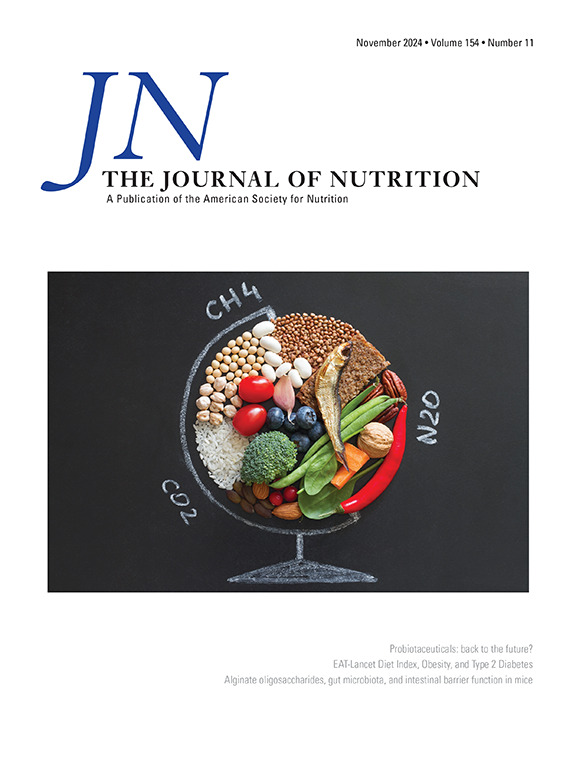膳食氨基酸与卒中亚型风险:来自三个大型前瞻性队列研究的结果。
IF 3.7
3区 医学
Q2 NUTRITION & DIETETICS
引用次数: 0
摘要
背景:饮食蛋白质的差异与卒中风险相关,可能存在卒中类型或蛋白质食物来源相关性的异质性。目的:我们研究了作为膳食蛋白质成分的单个膳食氨基酸与缺血性、出血性和全脑卒中风险的关系。方法:我们分析了护士健康研究(1984-2012)中的73830名女性、护士健康研究II(1991-2013)中的92333名女性和卫生专业人员随访研究(1986-2016)中的43268名男性的数据。通过有效的食物频率问卷评估22种(20种标准和2种非标准)氨基酸的膳食摄入量,通常每四年进行一次。采用多变量校正Cox回归模型估计缺血性、出血性和总卒中的风险比(hr)和95%置信区间(CIs)与能量调整后的单个氨基酸摄入量之间的关系。结果:在23.7年的平均随访中,记录了3058例缺血性卒中,872例出血性卒中和5997例卒中。经多重检验校正后,谷氨酰胺(HR / 1 SD高0.94,95% CI: 0.90-0.98, p值=0.004)和脯氨酸(0.94,0.90-0.98,p值=0.005)的摄入量较高,缺血性卒中风险较低。这些关联在敏感性分析中保持方向一致,但在相互调整后减弱。所有其他氨基酸,包括支链氨基酸,与缺血性脑卒中无显著相关性。对于出血性中风,没有观察到任何氨基酸的显著关联。对于总卒中,谷氨酰胺和脯氨酸也呈负相关(0.94,0.91-0.97,p值)。结论:谷氨酰胺和脯氨酸的高摄入量与缺血性卒中和总卒中的风险降低相关。本文章由计算机程序翻译,如有差异,请以英文原文为准。
Dietary Amino Acids and Risk of Stroke Subtypes: Results from 3 Large Prospective Cohort Studies
Background
Differences in dietary protein have been associated with stroke risk, with possible heterogeneity in associations by stroke type or food sources of protein.
Objectives
We examined the associations of individual dietary amino acids, as the constituents of dietary protein, with risks of ischemic, hemorrhagic, and total stroke.
Methods
We analyzed data from 73,830 females in the Nurses’ Health Study (1984–2012), 92,333 females in the Nurses’ Health Study II (1991–2013), and 43,268 males in the Health Professionals Follow-Up Study (1986–2016). Dietary intakes of 22 (20 standard and 2 nonstandard) amino acids were assessed using validated food frequency questionnaires, administered typically every 4 y. Multivariable-adjusted Cox regression models were used to estimate hazard ratios (HRs) and 95% confidence intervals (CIs) of ischemic, hemorrhagic, and total stroke in relation to the energy-adjusted intakes of individual amino acids.
Results
During a mean follow-up of 23.7 y, 3058 ischemic, 872 hemorrhagic, and 5997 total stroke cases were documented. After correction for multiple testing, lower risks of ischemic stroke were observed with higher intakes of glutamine (HR per 1 standard deviation higher: 0.94, 95% CI: 0.90, 0.98, P = 0.004) and proline (0.94, 0.90, 0.98, P = 0.005). The associations remained directionally consistent across sensitivity analyses but attenuated upon mutual adjustment. All other amino acids, including branched-chain amino acids, were not significantly associated with ischemic stroke. For hemorrhagic stroke, no significant associations were observed for any of the amino acids. For total stroke, inverse associations were also observed for both glutamine (0.94, 0.91–0.97, P < 0.001) and proline (0.96, 0.93–0.99, P = 0.004). In terms of dietary sources, glutamine was most strongly correlated with plant protein and whole grains, whereas proline was most strongly correlated with dairy protein and dairy products.
Conclusions
Higher intakes of glutamine and proline were associated with lower risks of ischemic and total stroke.
求助全文
通过发布文献求助,成功后即可免费获取论文全文。
去求助
来源期刊

Journal of Nutrition
医学-营养学
CiteScore
7.60
自引率
4.80%
发文量
260
审稿时长
39 days
期刊介绍:
The Journal of Nutrition (JN/J Nutr) publishes peer-reviewed original research papers covering all aspects of experimental nutrition in humans and other animal species; special articles such as reviews and biographies of prominent nutrition scientists; and issues, opinions, and commentaries on controversial issues in nutrition. Supplements are frequently published to provide extended discussion of topics of special interest.
 求助内容:
求助内容: 应助结果提醒方式:
应助结果提醒方式:


